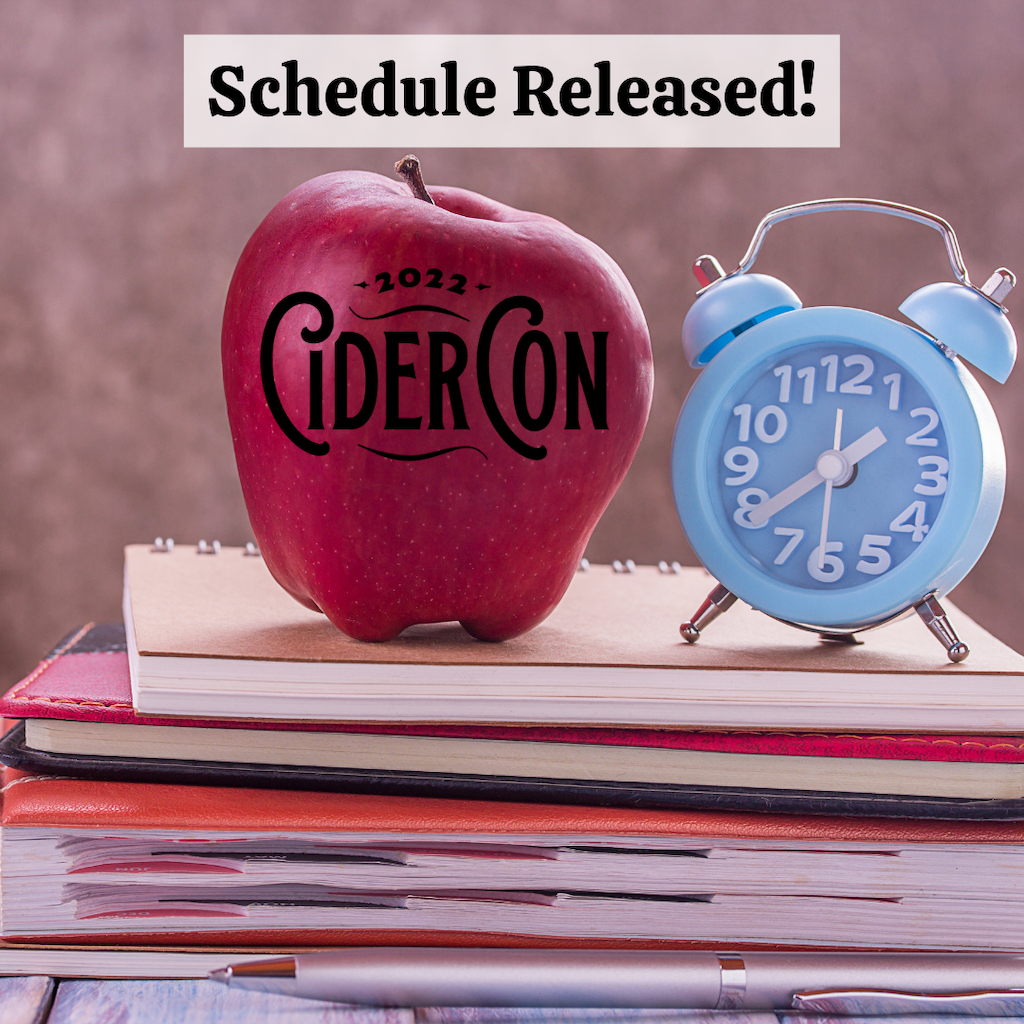Posts by Woodley Smith
Beer Kulture, ANXO Cider, and The American Cider Association Partner to Increase Diversity in the Cider Industry

ANXO, Beer Kulture Kollaboration Cider Will Help Fund Cider Scholarships
Beer Kulture, ANXO Cider, and the American Cider Association have partnered to introduce three scholarship opportunities designed to bring new Black, African American, Hispanic, Latino, Native North American, Pacific Islander, and other BIPOC individuals into the cider industry.
Each scholarship includes:
- Certified Cider Professional Level 1 bundle (including the exam)
- Two Certified Cider Professional Sensory Webinars
- Registration fee for the Certified Pommelier Exam
- Registration for the recipient and a guest to CiderCon®, the cider industry’s annual conference
- Travel to and from CiderCon® for the recipient and a guest
- Lodging at CiderCon® for the recipient and a guest
“We’re excited to expand into the cider industry with the work we’re doing,” said Latiesha Cook, CEO and President, Beer Kulture. “The broader alcohol space is large and offers so many opportunities to people of color as consumers, potential industry employees, and future owners that it makes sense for us to start looking at partnerships beyond beer. By bringing more people of color into these industries at every level, it creates new possibilities, not just as workers, but as founders, so they can own a piece of the space and drive the industry forward too. We’re really excited to work with ANXO and the American Cider Association for our first official scholarship and kollaboration in cider.”
While this is the first official cider scholarship and kollaboration for Beer Kulture, it’s not the group’s first foray into cider. Last year, the group worked with Michelle McGrath, Executive Director of the American Cider Association, to offer a package of free virtual registrations to CiderCon® 2021 to past Beer Kulture scholarship and internship winners. That package also included the Certified Cider Professional Level 1 exam and workshops.
“Last year’s partnership with Beer Kulture went so well that we wanted to continue the relationship with them this year,” explained McGrath. “Much like the beer industry, cider has historically struggled to diversify, especially beyond gender. Partnering with Beer Kulture is an opportunity for us to proactively reach people of new backgrounds and welcome them into our industry.”
This year, the partnership expanded to include Washington, D.C.’s ANXO Cider.
“We’re really focused on doing the work to help move the industry forward,” commented Rachel Topelius, co-founder and Director of HR and Community Outreach, ANXO Cider. “When we started talking with Latiesha and Michelle about this scholarship opportunity, we thought about how we could go further and drive more impact. After Latiesha mentioned that past Beer Kulture scholarship winners have given feedback that it can be intimidating being the only person of color at a conference, the idea came up to fund sending a plus one, to make each winner feel more comfortable and welcomed.”
The three scholarship packages will be funded by a new cider kollaboration from ANXO, Beer Kulture and the American Cider Association. The cider, a 7.3% ABV dry cider named Kulture, is a unique blend of 50/25/25 Albemarle Pippin, Dabinett, and Harrison apples, developed in conjunction by ANXO and Beer Kulture. The resulting liquid will be juicy with bold and gripping tannins producing a textured mouthfeel accompanied by balanced acidity.
“Kulture contains an exceptional blend of apples,” explained Sam Fitz, co-founder and President/Director of Production, ANXO Cider. “All the apples were sourced from Virginia and Pennsylvania within 100 miles of our facility in D.C. They were each then fermented naturally in wood prior to the blending.”
Black, African American, Hispanic, Latino, Native North American, Pacific Islander, and other BIPOC individuals interested in the scholarships are encouraged to apply by visiting this LINK.
Kulture, the new dry cider kollaboration, will debut at a release party at CiderCon® on February 2, 2022. Follow ANXO and Beer Kulture to learn more details about the release party closer to CiderCon®, including the time and location.
About Beer Kulture
Beer Kulture builds trust and strengthens communities by using craft beer to foster inclusion, equity and diversity. Together, we can change the world – one beer at a time. Learn more at www.beerkulture.com.
About ANXO Cider
ANXO Cider (pronounced Ahn-Cho) is a Washington, DC-based craft cidery inspired by centuries of American and European cider making culture. The idea of ANXO was first planted in the minds of Founders and Co-Owners Sam Fitz, Rachel Topelius, and Cooper Sheehan during a life-changing trip to the Basque country of Spain and the West Country of the United Kingdom where Sam was introduced to the rich history of farming and fermenting apples. ANXO’s mission is to grow cider culture in the US by creating and importing the finest ciders that are the purest expressions of the apples they are made from. ANXO makes cider much like vintners make wine, embracing an #ApplesOnly approach, using apples and yeast. Fermented in stainless steel or wood vessels the resulting product is sugar and gluten free and low-carb and is as complex as wine and accessible and sessionable as beer. Learn more at https://anxocider.com/.
About the American Cider Association
The American Cider Association is an organization of cider and perry producers in the United States. It gathers and shares information about cider production, regulations and cider apple growing to help members improve their operations, raise awareness and advance cider in the market. The organization was founded in February 2013. Learn more at ciderassociation.org.
CiderCon Session: Can I Say That? Health and Nutrition Labeling Restrictions and Requirements

Both the TTB and the FDA regulate what you can, can’t and MUST say on your cider packaging and in your promotions. Amidst a consumer-driven health craze, it’s important to know how these regulations impact your cidery. In this workshop, beverage-specialist attorney Marybeth Williams will walk you through these regulations when it comes to health claims and nutrition disclosures. She will cover the regulations for ciders both over and under 7% ABV.
About Marybeth Williams
Marybeth Williams is President of Williams Compliance and Consulting Group, LLC, near Richmond, VA, which provides compliance services and legal consulting to the alcohol beverage industry. She works with suppliers, focusing on the day to day compliance issues and trade practice parameters within which industry members must function. Ms. Williams graduated from the University of Denver College of Law in 1996, and has practiced in both the public and private sectors.
CiderCon Session: New Skins: How Brand Positioning & Packaging Design Can Reinvigorate a Category & Connect with New Drinkers

New CiderCon® 2022 Session! New Skins: How Brand Positioning & Packaging Design Can Reinvigorate a Category & Connect with New Drinkers
Beyond packaging trends and gimmickry, there’s an opportunity for every brand to better understand and communicate a meaningful story. As a brand strategist in the beverage alcohol space, Michael Kiser will share industry analogs and frameworks for aligning brand position, customer experience, and retail strategies that have helped companies new and old connect with their audiences.
About the Speaker
Michael Kiser is an innovation strategist (tech and CPG) working with some of the world’s largest and smallest brands to create innovation pipelines based on emerging market factors and consumer desires. He runs a boutique brand strategy and design practice in Chicago (Feel Goods Company), the world’s leading editorial voice in beer (Good Beer Hunting), and a cross-industry insights newsletter and community for beverage alcohol (Sightlines.news).
Creating Consumer Excitement with Food Pairing Suggestions

Pairing food and cider is an important key to helping people learn to love the complexities and nuances of cider, but we all understand that it can be tricky business. Join us for a dive into putting theory into practice in this session with our Cider Education Outreach Manager, Jennie Dorsey at CiderCon® 2022 in Richmond, Virginia from February 1-4, 2022.
Creating Consumer Excitement with Food Pairing Suggestions
We all know the “Four C’s” of food pairing, but putting theory into practice can be a little intimidating, especially for members of your tasting room staff that are just beginning their adventure with cider. In this session, cider and food pairing expert Jennie Dorsey will walk you through a pairing framework (with tasting samples!) that you can take back to your business, train your staff, and watch your sales grow.
About Jennie Dorsey
Jennie Dorsey is founding member of Pomme Boots Society for women in the Cider Industry and has held numerous positions since she first entered the Cider Industry over a decade ago. Jennie actually began her journey in the coffee industry where she was a nationally ranked competition barista and trainer specializing in sensory analysis with a focus on food pairings. The skills honed in competition led her on the path of beverage discovery, where she fell in love with cider and it’s unmatched pairing possibilities. Jennie is a working member of the Cider Certification team, and she was given the distinguished award of Cider Server of the Year in 2018 by the ACA. Jennie is passionate about food and beverage of all kinds, cinema, vintage lifestyle and can always be spotted by her brightly colored hair. She joined the ACA staff in 2021 as our Cider Education Outreach Manager.
An Intro to Holistic Orcharding for Novice Growers
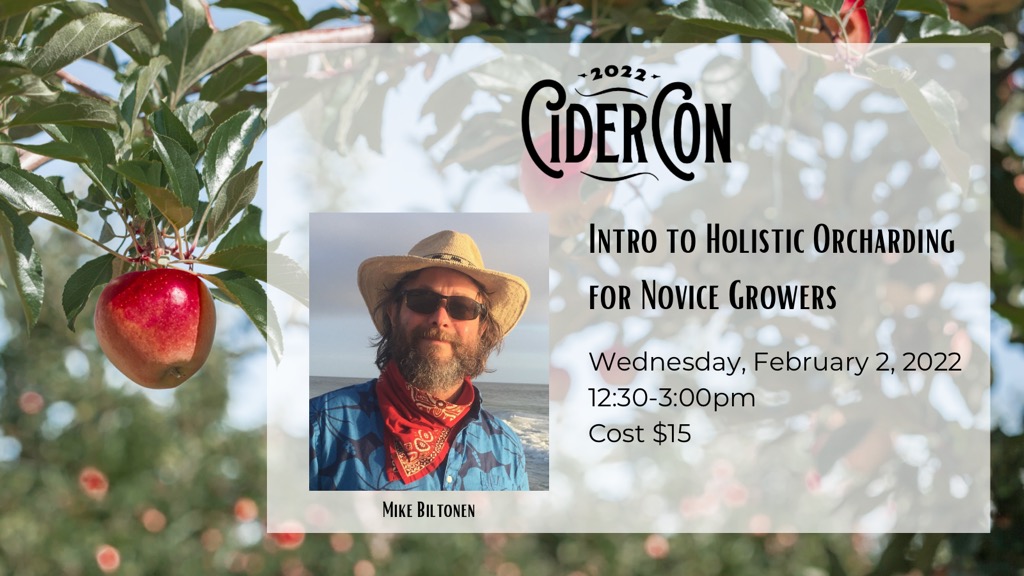
Intro to Holistic Orcharding for Novice Growers
The American Cider Association is pleased to announce that Mike Biltonen will lead an Intro to Holistic Orcharding for Novice Growers workshop at CiderCon® 2022. In this seminar we will cover the basics of what to look for when you’re seeking a site appropriate for your orchard, whether it be in your backyard, on the adjoining hillside, or in the next county. We will discuss climate, land, and soil characteristics as well as horticultural considerations you need to ponder before you plant the first tree. We will also cover the steps for designing and planting your first trees, as well as the first year’s management focus.
This course will take place Wednesday, February 1, 2022 at the Richmond Marriott Hotel from 12:30-3:00pm. The cost to attend is $15. Be sure to add it on during registration.
About Mike Biltonen
Mike Biltonen has spent nearly 40 years in agriculture – working mostly with orchards, vineyards, and specialty veg and fruit crops. He specializes in all aspects of sustainable orchard production of apples, pears, and stone fruit. An early passion for sustainable agriculture evolved into a profound dedication to the principles and practices of ecologically-focused, biodynamically-driven farming. The last fifteen years Mike has worked as a consultant to novice and seasoned farmers and orchardists alike on all aspects of establishing and managing regenerative and integrated farmscapes. Mike also conducts workshops, seminars, webinars, and has a free newsletter for the truly dedicated. He co-owns Know Your Roots, a novel and innovative family-owned company, with his wife Debbie where they are synchronously using farming and herbalism practices to heal the Earth.
CiderCon 2022 Schedule Released
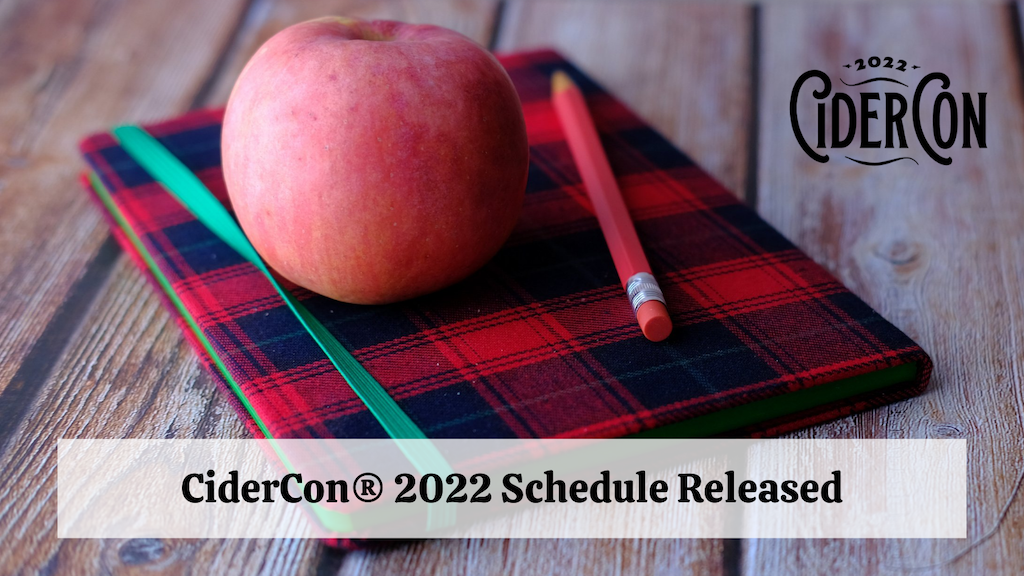
The American Cider Association is please to share the first draft of the CiderCon® 2022 Schedule! With tours, tastings, educational workshops, demos and more, CiderCon’s return to an in-person event is bound to be one of the most energetic CiderCons to date. Early registration numbers have been record breaking, with more than 400 people already signed up by November 15!
We’ve produced this draft schedule to help you with your CiderCon® 2022 planning. More session are being added each week and the schedule will be updated to reflect those additions. Session times may change as the schedule finalizes. Some sessions require separate registration which can be done during checkout. Details can be found on these sessions on the CiderCon® 2022 Registration page. Following our health & safety guidelines is necessary to participate.
For more details on all things CiderCon® 2022, you can head to the CiderCon® Website. You can download the draft schedule here.
Distributor Relationships & Social Media Advertising Sessions at CiderCon 2022
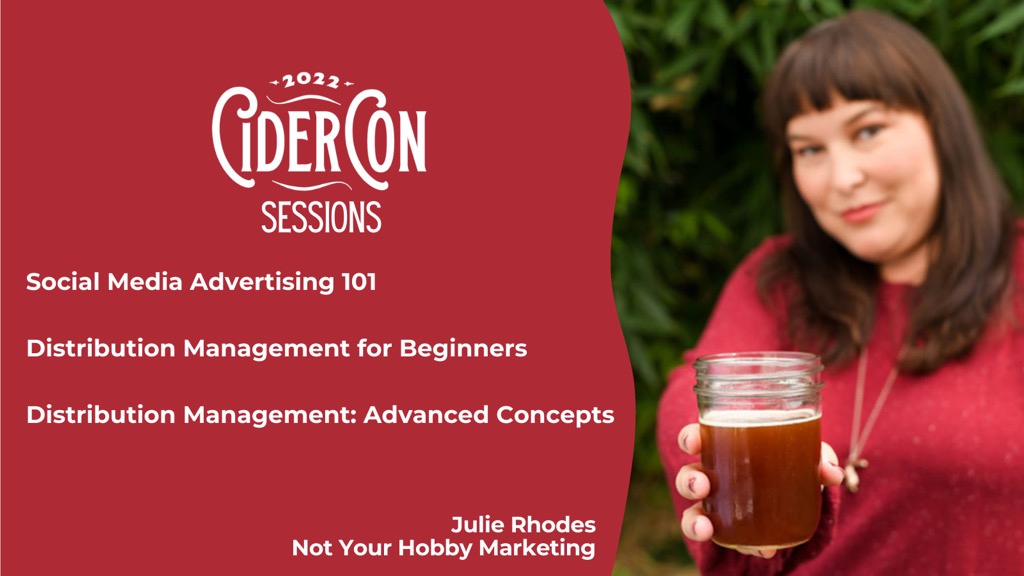
The American Cider Association is pleased to announce that Julie Rhodes of Not Your Hobby Marketing will present three sessions at CiderCon® 2022. Read on to learn more about Julie’s sessions and why you won’t want to miss them.
Social Media Advertising 101: How to Get Started with FB & IG Ads
Social media marketing should be a major component within your strategic business plans. But with organic reach of social media posts declining, that means less eyeballs on your cider brand. Learning how to formulate a paid social media advertising structure to add to your current organic content can help boost visibility, help build brand awareness and allow you to observe the purchase habits of your best customers. Join Julie Rhodes, owner of Not Your Hobby Marketing Solutions, for an interactive social media advertising presentation and workshop that will get you started with social media advertising.
Distribution Management for Beginners
Making the leap from on site sales to selling your cider products in retail is a big step, so wouldn’t it be helpful if there was some type of guidebook or instruction list for how to make this transition? Yes! Only that doesn’t exist, but lucky for you, this session on Distribution Management for Beginners led by Julie Rhodes of Not Your Hobby Marketing Solutions does. Learn the ins and outs, ups and downs, and best practices for those that are just getting started creating relationships with their distribution partners.
Distribution Management: Advanced Concepts
If you’ve been selling your cider brand with a distributor or wholesaler for a while, but are feeling a bit lost when it comes to strategic sales planning, this breakout session is right for you. Keeping your brand top of mind with your distributor personnel is vital if you want to succeed in the wholesale channel, but it’s how you accomplish this that seems to be a mystery to most. This session will explore the ways that you can implement strategic sales plans, interactive training, digital marketing, and advanced analytics to ensure that you’re building a long-term, profitable relationship with your distributor partner.
Julie Rhodes, Not Your Hobby Marketing
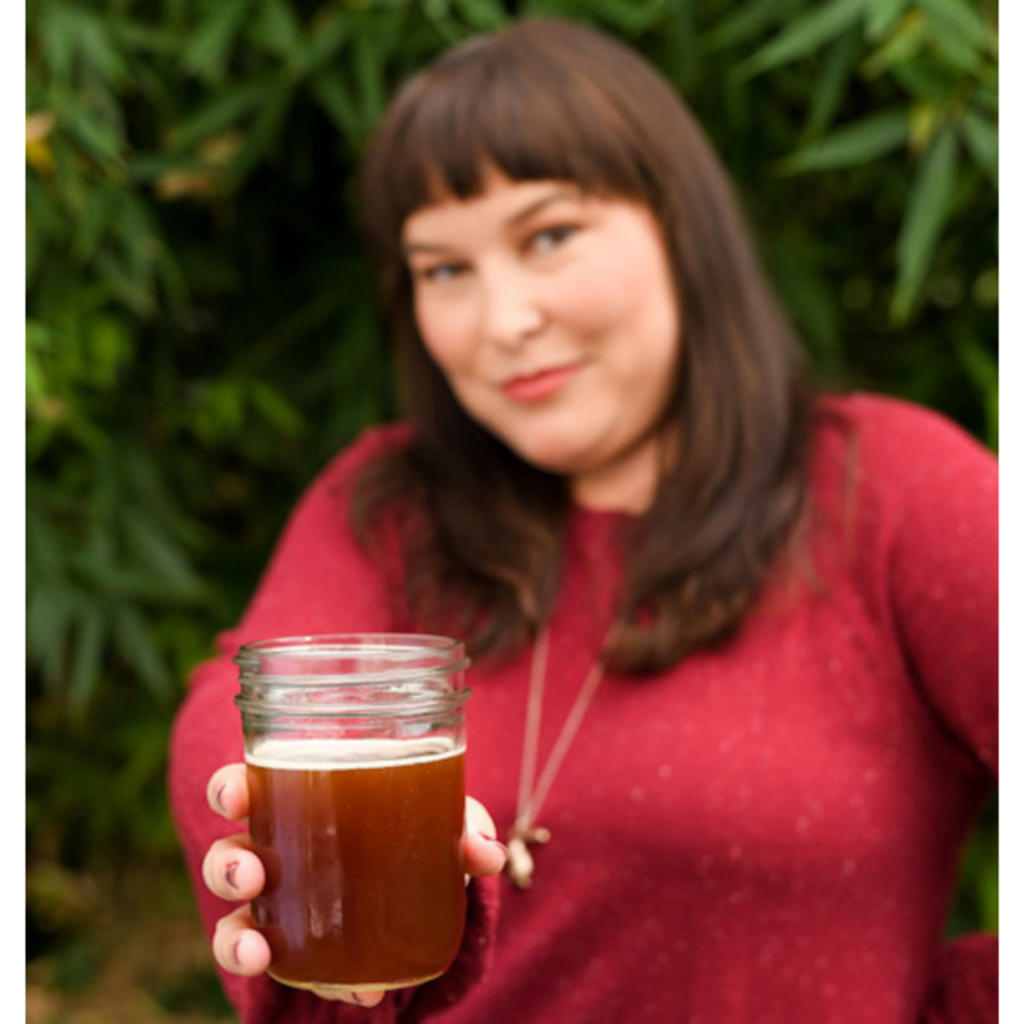
With over 20,000 hours of experience on the business side of the specialty beer industry, from field sales to digital marketing to regional management, a BA in Marketing from Texas State University at San Marcos, and more than 15 years of experience in the service industry, Julie Rhodes is an authority on beverage sales, marketing, sales team management, distributor partnership management, supply chain logistics, and customer service. She is the owner of Not Your Hobby Marketing Solutions, an educational services and consulting company that teaches sales, marketing & distribution management strategies to craft beverage professionals.
Webinar: Three-Tier Compliance & Regulatory Concerns for Cideries

Join the American Cider Association for the webinar Three-Tier Compliance & Regulatory Concerns for Cideries on December 9, 2021 at 11:00am Pacific Time. Alex Koral of Sovos ShipCompliant will lead this webinar.
What Will Be Covered In This Webinar?
As they expand, cider producers face a long list of complicated and evolving compliance and regulatory challenges in order for their cider to be distributed and sold in new states. Licensing, state and federal brand registrations, distribution agreements, and required follow-up reports make compliance a time-consuming and expensive process.
This webinar will spotlight the most pressing regulatory issues facing today’s cider producers involved in interstate distribution. Attendees will learn how to effectively, and cost-effectively, navigate regulatory and compliance risks.
- Get ahead of regulatory compliance to avoid delays in bringing new products to market
- Know the regulatory barriers that exist when entering new markets so you can expand your presence with minimal holdup
- Stay up to date on key regulatory issues impacting your business
This webinar is for active ACA members only. You can become a member or renew your membership here!
Our Speaker

Alex Koral, Regulatory General Counsel, Sovos ShipCompliant
Based in Boulder, Colorado, Alex Koral is Regulatory General Counsel for Sovos ShipCompliant, where he serves as lead legal researcher for beverage alcohol regulation and has become a leading expert on interstate distribution of alcohol. He has spoken on the topic at many industry events including Craft Brewers Conference, Craft Beer Professionals conferences, and meetings of the National Council of State Liquor Administrators and the National Liquor Law Enforcement Association. Alex has been in the beverage alcohol arena since 2015, after receiving his J.D. from the University of Colorado Law School.
Tiffanie Barriere, aka The Drinking Coach, to speak at CiderCon 2022

We are thrilled to announce that Tiffanie Barriere, aka The Drinking Coach, is speaking at CiderCon 2022 in Richmond, Virginia! Tiffanie is no stranger to cider, which is why we’ve asked her to demonstrate how to make killer low-ABV cider cocktails in her workshop at CiderCon. She’ll walk you through the steps so you can take these cocktails back to your tasting room program. Beyond the perfect cider cocktail, Tiffanie will also be weaving the history of Black bartenders in America into her presentation. Whether it’s cocktail construction or American alcohol history, walk away aware and A LOT smarter under The Drinking Coach’s tutelage.
Tiffanie Barriere is the bartender’s bartender, an influencer and educator who has been awarded with some of the beverage industry’s highest honors. The Bar Smart graduate is a Tastemakers of the South award-winner who spent seven years as the beverage director of One Flew South the “Best Airport Bar in the World.” As an independent bartender she is known for creative and innovative cocktail menus for pop-dinners and bar consultancy clients; hosting mixology classes around the nation, and connecting culinary and farm culture with spirits. As a leader, she is a member of the Tales of the Cocktail Grants Committee, the James Beard Beverage Advisory Board, and a member of the Atlanta chapter of Les Dames d’Escoffier.
“The Drinking Coach” Barriere has graced the demonstration stages of prestigious food and hospitality events such as the Atlanta Food & Wine Festival, Charleston Food & Wine Festival, BevCon, Tales of the Cocktail, Savannah Food & Wine Festival, Music to Your Mouth and more. As an author-contributor, Tiffanie’s cocktail recipes can be found in the Southern Foodway Alliance Guide to Cocktails by Jerry Slayter, Jubilee by Toni Tipton Martin, and Road Soda by Kara Newman.
Her reputation as a public historian has opened doors for her to speak on panels at such venues as Fire, Flour & Fork, Southern Foodways Symposium, and the Soul Summit, and she has interpreted the cocktails of African American and women firsts in spirits at the James Beard House in New York City.
The culinarians and chefs she has worked with reads like a Who’s Who in the Culinary Arts: Duane Nutter, Todd Richards, the late Darryl Evans, Kevin Mitchell, Deborah VanTrece, Jennifer Hill Booker, Suzanne Vizethann, Erika Council, Todd Ginsberg and Asha Gomez.
Barriere and her cocktails have been featured in such publications as Imbibe magazine (print and online), Difford’s Guide, Creative Loafing, Forbes, Essence, Southern Living, The Bitter Southerner, Cherry Bomb, Washington Post, Thrillist, Eater, Vine Pair, Food Republic, and Garden & Gun. In 2020 Tiffanie was featured on Food Networks The Kitchen showcasing her creativity on how to batch for more than 2 people. She also received the Tales of the Cocktails Dame of the Year award in 2020 and the cover photo of Imbibe Magazine for the Top 75 for Imbibe.
The Louisiana-Texas native is the trustworthy mentor of some of the best bartenders and mixologists in the world. Tiffanie’s main goal is education, service and fun with every pour.
5 Reasons to Register for the Certified Pommelier Exam

CiderCon® is right around the corner, and that means so is your next chance to join the elite crew of Certified Pommeliers™ that are spreading the good word about cider around the country. The exam itself will take place on February 1, 2021 during CiderCon® at the Richmond Marriott Hotel. That leaves plenty of time to prepare and we have plenty of resources to help you (see below)!
5 Reasons to Register
Still on the fence about taking your exam? We can think of a few reasons why you should:
- Research. That’s right, drinking lots of different ciders (as if we needed a reason) will actually help you prepare for your exam!
- Mastery. You too can be a master of the language of cider and help share that knowledge with others.
- Prestige. Pass your exam and show the world that you are one of the top experts in the cider industry.
- Experience. By learning more about the intricacies of cider you learn to love cider even more.
- Camaraderie. When you pass your exam you will join an amazing group of cider professionals that love cider and spreading the love just as much as you do.
- Okay, we said 5 reasons, but really, we thought mentioning research (a.k.a. drinking cider) again might be worthwhile.
Register Now!
For ACA members, the exam is $125 per attempt. There is a discount code that members can access to receive the exam at the membership rate of $125. That discount code can be found here. For non-members, the exam is $200. You can register for the exam here.
Get Studying!
Now, about those resources we mentioned. When you sign up to take your Certified Pommelier™ exam, you will be provided with a study guide and access to webinars to help you develop your knowledge and skills.
There are several books that will also help you further develop your understanding of cider, apples and history. We have created a list with our recommended reading materials. You can access this list by clicking here.
And there’s a dedicated Facebook Group with prep materials and in depth peer conversations.
Want more to fortify your cider knowledge? We highly recommend interviewing cidermakers and cider tenders to help prepare. Blind tasting flights are also good prep. See research in our list above!
Questions?
Contact our Cider Education Outreach Manager Jennie Dorsey with any questions you might have.
Don’t miss out on you chance to join this elite community of cider professionals by taking the Certified Pommelier™ Exam at CiderCon® 2022 in Richmond, Virginia in February!
A huge thanks to our CCP and Certified Pommelier™ sponsor:






